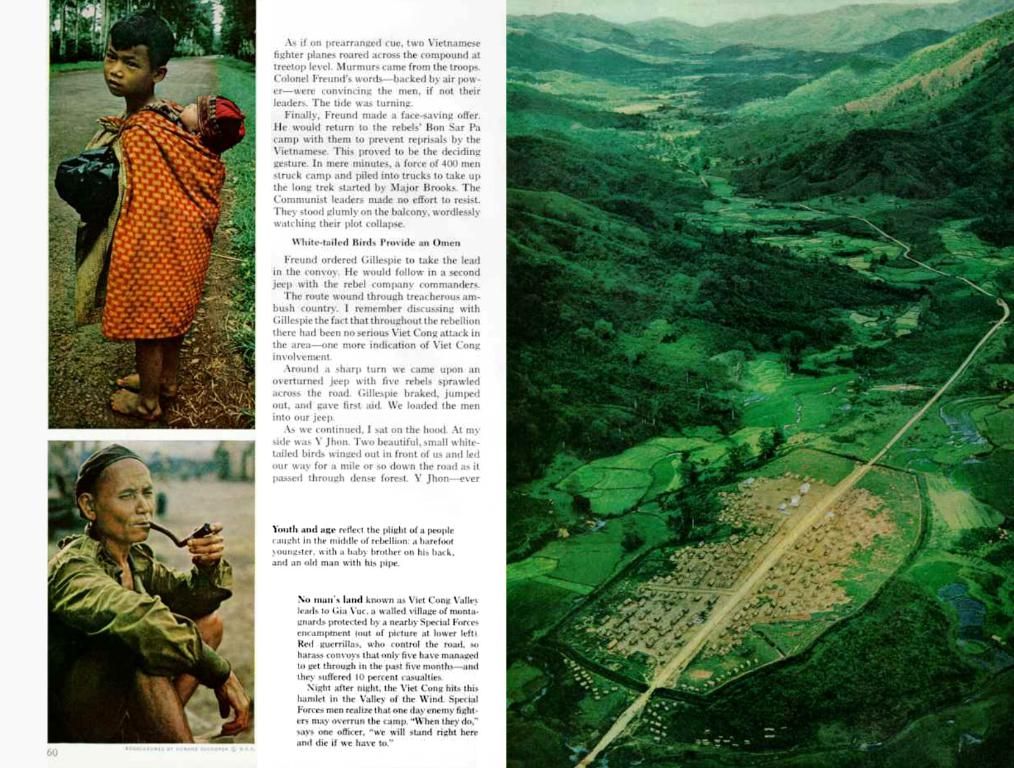Mount Everest Goes High-Tech: Drones Take Over Supplies and Waste Removal
Aerial vehicles deliver goods to Mount Everest peak.
Save time, save lives, that's the mantra of Mount Everest’s latest innovation: drones. No longer just for measurements and filming, these unmanned aerial vehicles have found a new purpose on the world's highest peak.
In the heart of the Himalayas, drones are making waves in waste removal and cargo transport, making the tough climb to the 8,849-meter-high summit safer and easier for Sherpa guides and climbing enthusiasts.
"Our drones are a game-changer," says Raj Bikram Maharjan, CEO of Airlift Technology, based in Kathmandu. "What used to take Sherpas seven hours now takes just seven minutes. It's freaking amazing."
These drone wonders carry ladders, tents, ropes, and oxygen bottles—all essential tools for the climbers, reducing the number of trips through the dangerous Khumbu Icefall, a treacherous zone with ice towers and crevasses.
Maharjan's drones, the FlyCart 30, fly between the base camp and Camp 1, located above 6,000 meters, supporting the Sherpa teams that help hundreds of climbers from all over the world each year in their quest to reach Everest's peak.
The Safer Route
The increased use of drones is a significant improvement over traditional transportation methods, which can be dangerous and exhausting. In the past, human porters or donkeys handled the heavy loads, while in higher altitudes, yaks took over. However, drones eliminate the risks associated with these methods, as well as the costly helicopter rides.
Although the initial goal was waste removal, the drones' success in this area led to their adoption by Airlift Technology. The Khumbu Pasang Lhamu municipality, the Sagarmatha Environmental Protection Committee, and DJI continue supporting the drone operation to keep the Khumbu Glacier route passable and waste-free.
In just one year, the use of drones transformed Mount Everest expedition logistics, with oxygen bottles delivered to Camp 1, waste removal, and survey of the Khumbu Icefall to find new, safer routes.
A Brighter Future
While the high costs might deter small expeditions, Maharjan sees a bright future for drones on Mount Everest and the rest of the Himalayas. "Drones are like a silver bullet on Everest. They're efficient, safer, and cheaper. Drones have a bright future here."
Like any newly-embraced technology, concerns over job security have arisen. However, Maharjan assures that local Sherpas remain happy with the drone refrigerator. "Sherpas have been working in these dangerous conditions for centuries. They're wise, they understand that the drones are here to make their lives easier, not replace them."
Numbers back up this claim, as a third of the 227 deaths on Everest's south side between 1953 and 2024 occurred within the Khumbu Icefall, a notorious danger zone[3]. Drones can navigate these treacherous walks, minimizing human exposure and lowering the risk of fatal accidents.
Navigating the Sky
While helicopters are often seen as the technological brethren of drones, Jost Kobusch, a German climber, values drones' smaller size and quiet operation over their louder flying contraptions. "I'd rather have drones taking footage than helicopters. It's annoying when helicopters fly over the mountains; it sounds like a busy highway." [2]
However, Kobusch, who made a solo tour of Everest in the winter, still prefers to avoid such devices in his climbing endeavors.
As drones continue to revolutionize mountaineering, one thing is clear: the brave souls who dream of climbing Everest are getting a helping hand—or in this case, a flying leg-up—thanks to advanced technology.
[1] Dirk Godder and Roshan Sedhai, dpa, ntv.de[2] Personal interview with German climber Jost Kobusch, 2024[3] Himalayan Database[4] Airlift Technology[5] DJI Technology
- As the technological revolution reaches the peaks of Mount Everest, consumers worldwide are now considering incorporating drones into their mountaineering lifestyle, prepared to adapt the latest gadgets and harness the power of technology for safer expeditions.
- With the introduction of drones as a viable alternative for waste removal, cargo transport, and survey of dangerous routes, the Himalayan region may soon witness a multitude of changes in its environmental protection methods and travel practices, ultimately paving the way for a more sustainable, high-tech lifestyle.
- As sports and travel enthusiasts strive to conquer the world's highest peak, they'll find that advancements in sports equipment, such as the quiet and nimble FlyCart 30 drones, will significantly impact their climbing experience, reducing risks and improving efficiency on the challenging route up Mount Everest.





